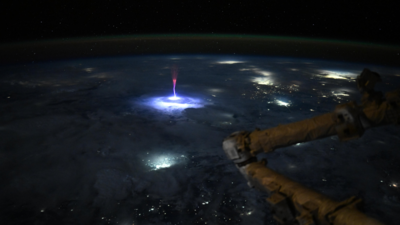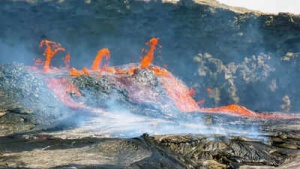NASA astronaut Nichole Ayers has captured a stunning image of a Transient Luminous Event (TLE), also known as a "sprite," from her vantage point high above North America. The image reveals glowing red lights shimmering in Earth's upper atmosphere, a rare phenomenon triggered by thunderstorms over Mexico and the United States.

A rare red sprite, as captured by astronaut Nichole Ayers from the International Space Station.
Sprites are massive bursts of electrical energy that occur high above powerful thunderstorms, reaching up to 100 kilometers above Earth’s surface. Unlike typical lightning, they consist of “cold plasma,” similar to the glow inside a fluorescent light tube.
The fleeting nature and high altitude of sprites make them rarely visible from the ground. Astronaut Ayers shared the image on X, saying, “Just. Wow. As we went over Mexico and the U.S. this morning, I caught this sprite.”
“Sprites are TLEs or Transient Luminous Events, that happen above the clouds and are triggered by intense electrical activity in the thunderstorms below,” she further explained.
The Mystery of Sprites
For decades, pilots reported seeing these brief, jellyfish-shaped flashes, but many scientists dismissed them as optical illusions. It wasn't until 1989 that the first clear image of a sprite was accidentally captured on camera, confirming their existence.
NASA explains that sprites occur when strong lightning discharges interact with Earth’s ionosphere. The reddish glow is produced as the discharge travels upward and collides with nitrogen molecules. Sprites are part of a broader category of upper-atmosphere phenomena, including blue jets and red elves.
The image shared by Ayers has sparked both amazement and curiosity online. One user commented, “Sprite.... one of the rarest of rare celestial phenomenon.”
Another user inquired, “How long do the sprites last? Is this a still shot taken from a video? What altitude did this one reach? The more we find out, it becomes obvious we know far less than we thought.”
Newer articles
Older articles
 Bezos-Backed Methane-Tracking Satellite Mission Ends Abruptly After Loss of Contact
Bezos-Backed Methane-Tracking Satellite Mission Ends Abruptly After Loss of Contact
 Africa's Rift Valley: Mantle Upwelling Fuels Volcanic Activity, Foretelling New Ocean Birth
Africa's Rift Valley: Mantle Upwelling Fuels Volcanic Activity, Foretelling New Ocean Birth
 7 Proven Habits to Nail Your Next Job Interview: Project Confidence and Authenticity
7 Proven Habits to Nail Your Next Job Interview: Project Confidence and Authenticity
 Smith Targets Test Return After Innovative Baseball Cage Rehab in New York
Smith Targets Test Return After Innovative Baseball Cage Rehab in New York
 5 Subtle Signs of Prediabetes You Shouldn't Ignore
5 Subtle Signs of Prediabetes You Shouldn't Ignore
 Oral Cancer: Know the Warning Signs, Risk Factors, and Why Early Detection is Key to Survival
Oral Cancer: Know the Warning Signs, Risk Factors, and Why Early Detection is Key to Survival
 Hair Oil vs. Serum: Which Elixir is Right for Your Hair Type? A Comprehensive Guide
Hair Oil vs. Serum: Which Elixir is Right for Your Hair Type? A Comprehensive Guide
 Blackcaps and White Ferns Face Packed Home Summer Against Cricket Heavyweights
Blackcaps and White Ferns Face Packed Home Summer Against Cricket Heavyweights
 Gambhir Defends India's Tailenders After Headingley Collapse; Cites Dropped Catches as Key Factor in Test Loss
Gambhir Defends India's Tailenders After Headingley Collapse; Cites Dropped Catches as Key Factor in Test Loss
 England Captain Stokes Lauds Duckett and Crawley for Blistering Start in Record Chase Against India
England Captain Stokes Lauds Duckett and Crawley for Blistering Start in Record Chase Against India